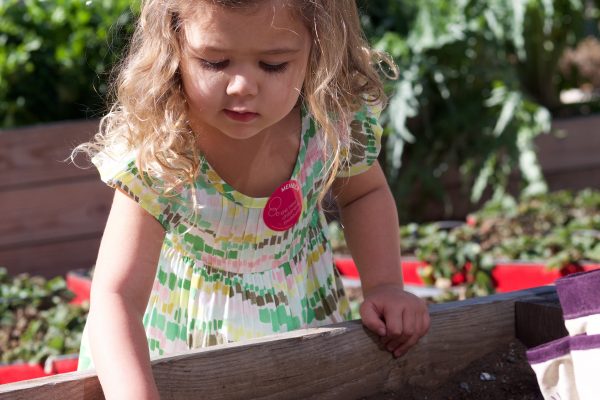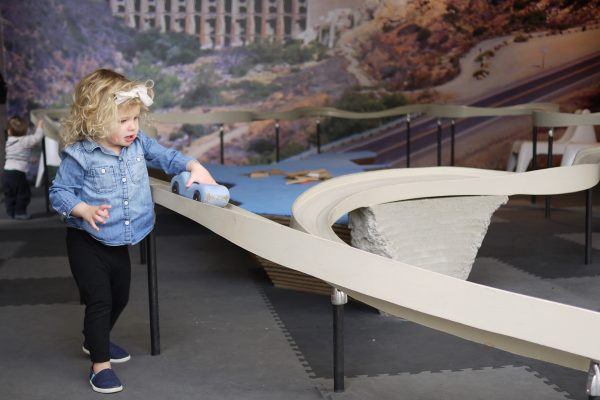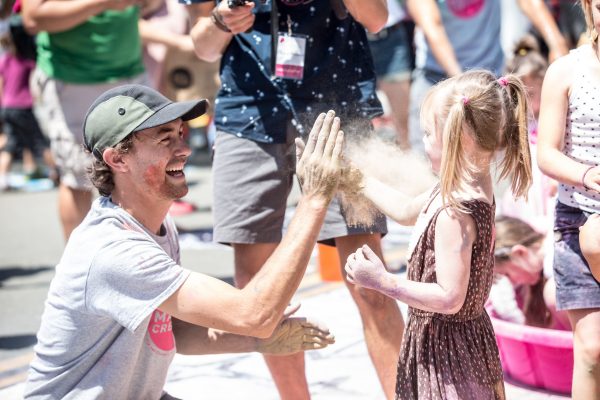do it yourself: groovy dip dye art
Tie dye is not just for T-shirts! Kids can create fun and unique designs on paper towels using food coloring and water. Experiment with the different ways to fold, scrunch and twist paper, and enjoy the surprising, colorful results that come from it!
guidelines + materials
AGE: 4+ (with adult support)
TIME FRAME: 30 minutes
SUPPLIES:
- Paper Towels (coffee filters as alternative)
- 1 Package of Liquid Food Coloring
- 3 – 4 Small Bowls
- 1 Tablespoon of Water (per color)
- Newspaper or Disposable Tablecloth
directions
1. Mix the colors. In a small bowl, mix 4 – 5 drops of one color of food coloring with a tablespoon of water and stir it. Make a bowl for each of the colors red, yellow and blue. In an extra bowl, try mixing two colors together to create a new color. You can also wait and simply dip the same area of your paper into more than one color to blend colors that way. Do not worry about making a small amount of each color – a little goes a long way!
2. Fold the papers. Grab 3 – 4 paper towels (or coffee filters). Ready the papers for dipping by first folding, twisting or scrunching them. Explore the many ways that you can manipulate your papers. The way that the paper is prepped will affect the patterns made by the dye. Have fun folding, twisting and scrunching your papers in various ways to create different results!
3. Dip dye your paper. Once you have your papers ready, lay out a few sheets of newspaper or a disposable tablecloth onto your work surface. Then, one at a time, dip each paper lightly into the dye colors – moving the paper around to hit multiple corners of the paper. The paper towels will quickly absorb the colors, so be careful not to soak them too heavily with the dye while dipping. As mentioned before, have fun dipping one edge into more than one color to see new colors form. Once you’re finished with dipping, set each paper aside for a moment before unfolding them.
4. Reveal your designs. It’s time to see your designs! One at a time, gently unfold your dyed papers and lay them out on the newspaper/tablecloth. Notice the differences between the designs. If interested, you could use a paper and pencil to record the results of each fold. If you have more paper towels, keep experimenting and create new designs! You can also try folding your paper back up and dipping it again on top of the first layer of colors.
5. Dry your work and share it! Lay your papers out to dry. Depending on how soaked they are by the dye, they may take up to an hour to fully dry. Once dry, share your amazing results with others! Let your family and friends see the groovy patterns you’ve made and talk to them about how you made them. What surprised you while making them? Do you have a favorite design that came from your experiments? Share your discoveries!
Additional Learning Activities (Grades K – 4)
Tie Dye Collage
Use your dyed papers to make another wonderful work of art. Cut up your papers into smaller pieces to create a fun collage by gluing them onto another solid color paper. You can make an image of something recognizable or just a beautiful abstract design!
Wrap It Up
Use your papers to wrap a present or to make greeting cards. These designed papers are also beautiful gifts in themselves – think about how you might frame them and give them out as presents to friends or family members.
Select a Story!
Reading is a wonderful vehicle for learning and for introducing new ideas to learners. Select engaging and age-appropriate books that feature color mixing or experimenting with art and read them to your child before and/or after the Groovy Dip Dye Art activity.
Recommended Related Reading (Ages 4 – 10):
- A Splash of Red: The Life and Art of Horace Pippin by Jen Bryant and Illustrated by Melissa Sweet
- Art by Patrick McDonnell
- Never Let a Princess Paint with Her Unicorn by Diane Alber
- Swatch: The Girl Who Loved Color by Julia Denos
CA Arts Standards for Visual Art (Grades K – 4)
- Engage in exploration and imaginative play with various arts materials.
- Explore uses of materials and tools to create works of art or design.
- Discuss and reflect with peers about choices made in creating artwork.
- Create personally satisfying artwork using a variety of artistic processes and materials.
- Brainstorm individual and collaborative approaches to a creative art or design problem.



